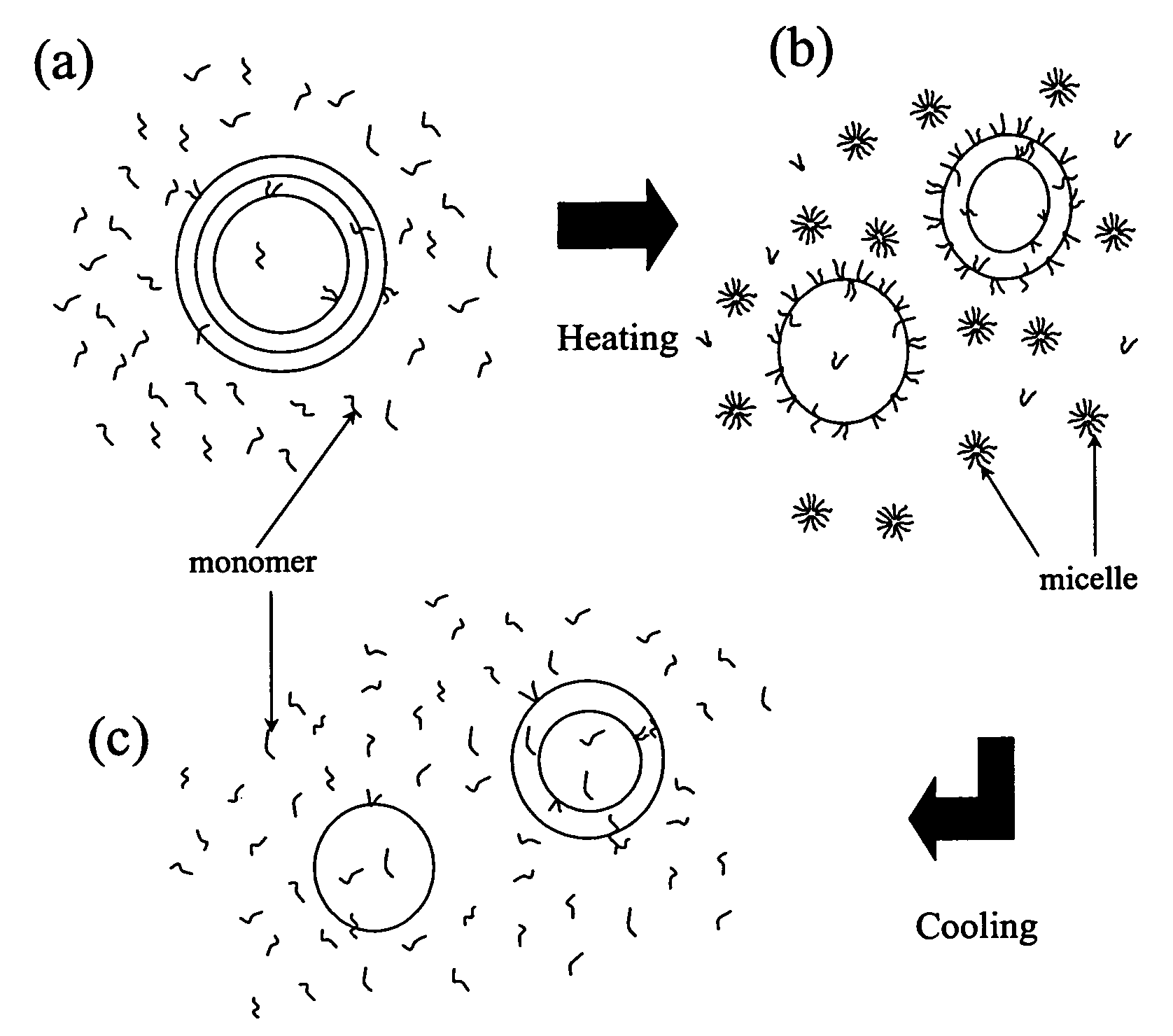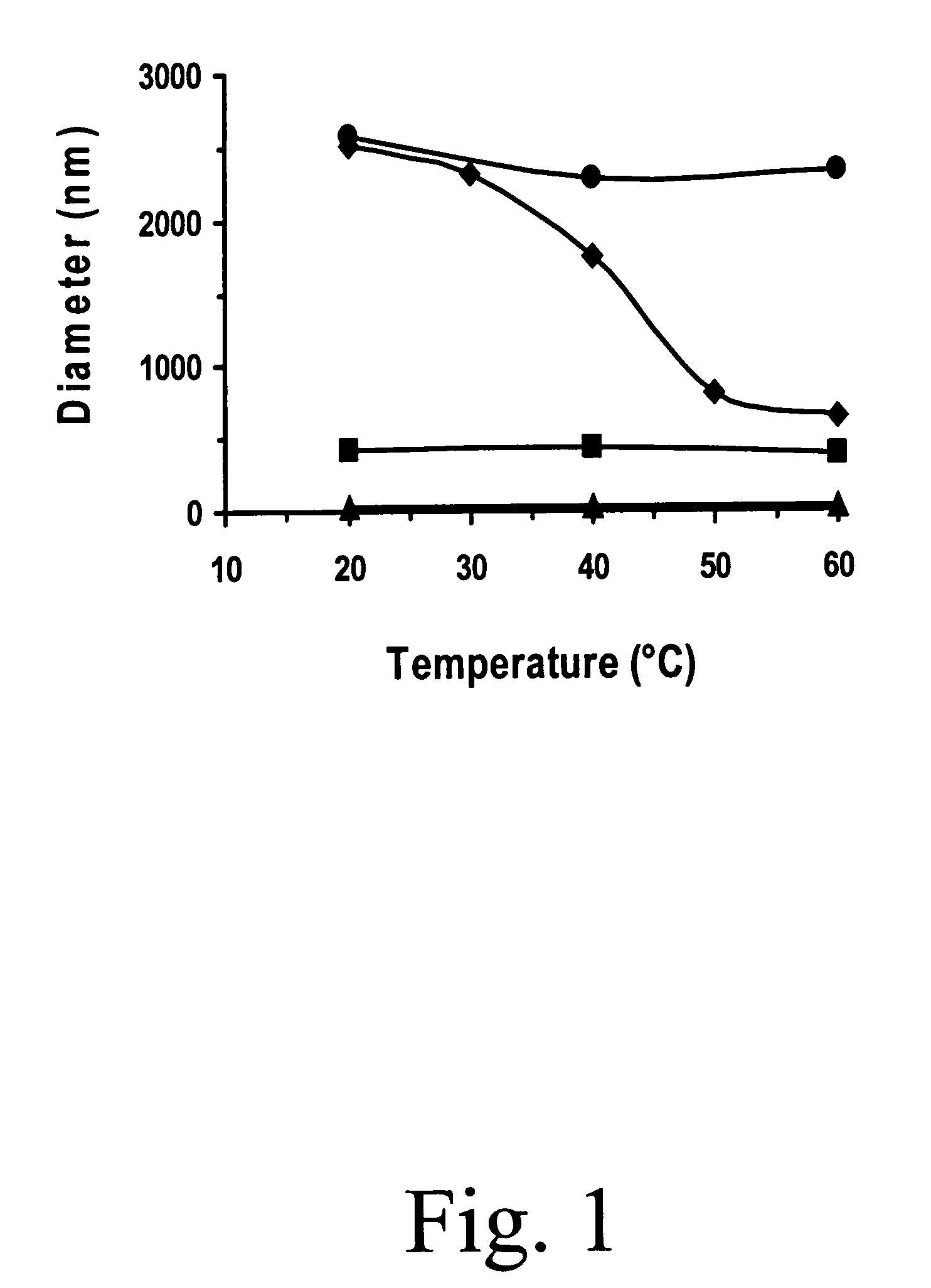Temperature sensitive control of liposome-cell adhesion
a liposome cell and temperature sensitive technology, applied in the field of delivery of drugs, can solve the problems of no method available, difficult to detect or desteal the peg coated liposome at the desired site, etc., and achieve the effect of reducing the adhesion of the liposome cell
- Summary
- Abstract
- Description
- Claims
- Application Information
AI Technical Summary
Benefits of technology
Problems solved by technology
Method used
Image
Examples
example 1
[0031]This embodiment describes the preparation of liposomes useful for the present invention. To illustrate this embodiment the preparation of liposomes with EPC and Pluronic F-127 is described. All the lipids, i.e., egg phospatidylcholine (EPC), di-oleoyloxy-trimethylammonium propane methyl sulfate (DOTAP), di-palmitoyl Rhodamine phosphatidylethanolamine (DPRhPE) and di-stearoyl(polyethylene glycol 5000) phosphatidylethanolamine (PEG5000-DSPE) were purchased from Avanti Polar Lipids Inc. (Alabaster, Ala.). The lipids were stored at −80° C.
[0032]All liposomes were made with EPC and different mole (or weight) % of Pluronic F127. Multi lamellar vesicles (MLV), large unilamellar vesicles (LUV) and small unilamellar vesicles (SUV) were made for different experiments. Pluronics were either co-solubilized with the lipid during preparation of liposomes or added afterwards to the already formed liposomes. For cell adhesion experiments, DOTAP and DORhPE were added to make the liposomes.
[003...
example 2
[0034]This embodiment describes the effect of poloxamer, in this example, Pluronic F-127, on the size of the EPC vesicles during temperature change. To illustrate this embodiment, MLVs comprising EPC, DOTAP and DPRhPE were made as described in Example 1. All samples were made, at 4° C., with EPC and 8 mole % DOTAP. The “control” MLVs did not have any Pluronic F127 while the “F127” MLVs had 0.03% (w / v) Pluronic F127 in the sample environment.
[0035]The lipid concentration of each sample was 1.1 mg / ml and final Pluronic F127 concentration in the liposome solution was 0.032% (w / v). All the samples were made at 4° C. The temperature was gradually cycled from 4° C. to 41° C. to 4° C. during measurement. During the experiment, the sample to be measured was kept at the desired temperature by a Peltier unit of the QLS machine. Each sample was kept in the sample chamber for at least 15 minutes, to achieve thermal equilibrium, before starting measurement. All the other samples, used in the sam...
example 3
[0040]This embodiment demonstrates visualization of association of Pluronic F-127 with liposomes at different temperatures. The negative-stain electron microscopy of the Pluronic-containing liposomes was used to examine the association of the Pluronic with liposomes at different temperatures. EPC liposomes, with or without 1 mole % (0.03% w / v) Pluronic F127, were prepared and then temperature treated, as described herein. Pluronic 127 at a concentration of 0.03% (w / v) has a CMT of about 35° C. Negative staining samples were prepared below CMT (4° C.) and above CMT (41° C.) to observe the behavior of Pluronic F127 molecules in the presence of lipid vesicles at two significantly different temperature conditions. The temperature treated liposomes were used as samples for negative staining.
[0041]The results are presented in FIG. 2 which consists of micrographs showing images of negative stained EPC MLVs at different temperatures. FIG. 2 (a, b) are control samples consisting of EPC MLVs ...
PUM
| Property | Measurement | Unit |
|---|---|---|
| critical micellar temperature | aaaaa | aaaaa |
| critical micellar temperature | aaaaa | aaaaa |
| diameter | aaaaa | aaaaa |
Abstract
Description
Claims
Application Information
 Login to View More
Login to View More - R&D
- Intellectual Property
- Life Sciences
- Materials
- Tech Scout
- Unparalleled Data Quality
- Higher Quality Content
- 60% Fewer Hallucinations
Browse by: Latest US Patents, China's latest patents, Technical Efficacy Thesaurus, Application Domain, Technology Topic, Popular Technical Reports.
© 2025 PatSnap. All rights reserved.Legal|Privacy policy|Modern Slavery Act Transparency Statement|Sitemap|About US| Contact US: help@patsnap.com



